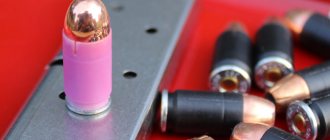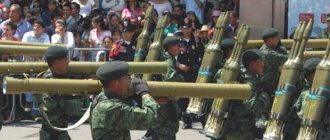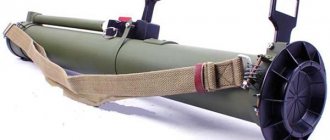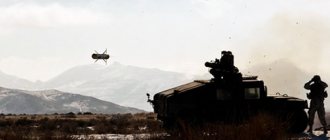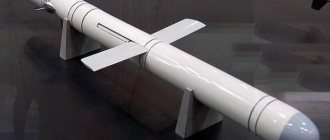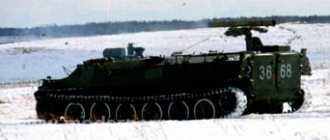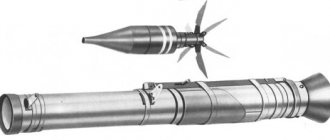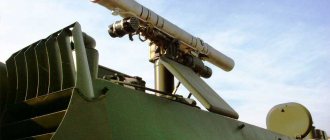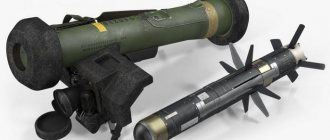M-69 gun. Anti-tank ram with 152 mm caliber
By the mid-fifties, the potential of missile weapons in the context of fighting tanks became obvious, but anti-tank guns were still in no hurry to become a thing of the past. Another attempt was made to create a promising anti-tank self-propelled artillery mount with a weapon of increased power. As part of the Taran research work, the Object 120 self-propelled gun and the 152-mm M-69 gun for it were created. In terms of their combat characteristics, both models were superior to all developments of their time.
"Object 120" in the museum. The barrel of the 152 mm M-69 cannon barely fits into the frame. Photo: Wikimedia Commons
Research work "Taran"
In May 1957, several resolutions of the USSR Council of Ministers set a course for the development of armored vehicles to combat enemy tanks.
The industry was tasked with developing several armored vehicles with guided missile weapons, as well as an artillery mount with a high-power weapon. The creation of self-propelled guns was carried out as part of the Taran research project. According to the technical specifications, the new self-propelled gun should have a mass of no more than 30 tons and be protected from small and medium caliber projectiles. For a self-propelled gun, it was necessary to create a large-caliber gun weighing no more than 4.5 tons with a direct shot range at a “tank” type target of 3 km. At such a distance, the gun was supposed to penetrate 300 mm of homogeneous armor at an impact angle of 30°.
The main contractor for Taran was OKB-3 of the Sverdlovsk Uralmashplant, headed by G.S. Efimov. The design of the gun was entrusted to the Perm SKB-172 chief designer M.Yu. Tsirulnikova. The shots were created at the Moscow Research Institute-24 under the leadership of V.S. Krenev and V.V. Yavorsky. Several other organizations were involved in research work as developers and suppliers of individual components and components.
Two guns
During the same year of 1957, a number of organizations led by SKB-172 were looking for the optimal design of a weapon for the future self-propelled guns.
Calculations have shown that the required ratio of fire characteristics and mass can be achieved by systems of 130 and 152.4 mm caliber. By the end of the year, SKB-172 completed preliminary designs for two similar guns. The 130 mm caliber product received the working designation M-68. The 152 mm gun was designated M-69. The M-68 project proposed a 130-mm rifled gun with a barrel length of 10,405 mm (80 calibers) for a separate-case-loading shot. The estimated initial velocity of the projectile reached 1800 m/s. The weight of the gun on the installation was 3800 kg - 700 kg less than the maximum permissible according to the technical specifications. It was proposed to attack armored targets using a specially developed armor-piercing sabot projectile weighing 9 kg. Its penetration characteristics corresponded to the customer's wishes. A high-explosive fragmentation projectile with a variable propellant charge was also provided.
The M-69 project included a 152-mm gun with a smooth barrel of the same dimensions. The relative length of the barrel is 68.5 calibers. The weight of the product reached the maximum permissible 4500 kg. The estimated maximum projectile speed was 1700 m/s. Against tanks, the gun was supposed to use an 11.5 kg armor-piercing sabot projectile or cumulative ammunition. Fortifications and manpower could be attacked with a high-explosive fragmentation projectile.
Model of self-propelled gun "Taran". Photo Russianarms.ru
In February 1958, at a meeting at the State Committee for Defense Equipment, taking into account the results of the research, the terms of reference were changed. In particular, the range of a direct shot at a target 3 m high was reduced to 2.5 km. Other requirements remain the same. Now the enterprises had to produce and test experimental guns of two types.
The production and subsequent shooting of the M-68 and M-69 products took about a year. The barrel groups were manufactured by factory No. 172. We received ammunition from related enterprises. The tests were carried out at the plant's test site using the M36-BU-3 ballistic installation. During test firing, it was possible to confirm the main tactical and technical characteristics of the guns.
In March 1959, a new meeting was held at which the final appearance of the future self-propelled gun “Taran” or “Object 120” was determined. When choosing a gun for a self-propelled gun, the deciding factor was the range of ammunition. The 130-mm M-68 cannon could only hit tanks with a sub-caliber projectile, while the M-69 also had cumulative ammunition. Due to greater flexibility of use, a smooth-bore 152-mm gun was recommended for further development and use on the Taran.
At the very beginning of the next 1960, Uralmashzavod received two experimental M-69 guns for installation on the Object 120. Soon the only prototype of a self-propelled gun with such weapons entered factory testing.
Technical features
The finished product M-69, used as part of the Taran self-propelled gun, was a 152.4 mm smoothbore gun with a barrel length of 9.045 m, using separate case loading.
The breech of the gun was equipped with a semi-automatic wedge breech. An ejector was placed next to the muzzle. To partially compensate for recoil, a slot-type muzzle brake with 20 holes on each side was used. The gun mount had hydropneumatic recoil devices with a drag force of 47 tf. Due to the use of such devices and an effective muzzle brake, the maximum recoil length was only 300 mm.
Scheme of the “Object 120” with the M-69 cannon. Drawing Russianarms.ru
Vertical guidance of the swinging part with the gun was carried out by hydraulic or manual drive. Pointing angles – from -5° to +15°. The installation included a mechanism that automatically returned the barrel to the loading angle after each shot. The gun mount was located in a circular rotation turret, which ensured firing in any direction.
“Object 120” carried ammunition consisting of 22 rounds of separate loading. For faster feeding into the gun, shells and cartridges were placed in a drum stack. Due to this, the gun could fire 2 shots in 20 seconds.
Several shots for different purposes were developed for the M-69. To combat manpower and fortifications, a 152-mm high-explosive fragmentation projectile weighing 43.5 kg with a propellant charge of 3.5 kg (reduced) or 10.7 kg (full) was intended. The fight against armored vehicles was ensured by cumulative and sub-caliber projectiles weighing 11.5 kg. Together with them, cartridges with 9.8 kg charges were used.
The initial speed of the sabot projectile is 1710 m/s. The range of a direct shot at a target 2 m high is 2.5 km. The pressure in the barrel bore reached 4 thousand kgf/sq.cm. Muzzle energy – more than 19.65 MJ. The effective firing range reached several kilometers.
At a distance of 3.5 km, with a direct hit on the target, the projectile penetrated 295 mm of homogeneous armor. At a meeting angle of 60°, penetration was reduced to 150 mm. At a distance of 2 km, the gun could penetrate 340 mm (0° angle) or 167 mm (60° angle). At a distance of 1 km, the maximum table penetration value reached 370 mm.
Thus, the newest self-propelled gun “Object 120” with the M-69 cannon could successfully hit any existing armored vehicles of a potential enemy at ranges of up to several kilometers. It should be noted that according to some characteristics, a 152-mm gun from the early sixties can be compared with modern models.
Layout of "Object 120". You can evaluate the features of the placement of the gun. Figure Btvt.info
However, there were some noticeable shortcomings. First of all, the mobility of the self-propelled gun suffered, since the large length of the barrel increased the overall size of the armored vehicle. Despite the rear placement of the fighting compartment, the muzzle of the barrel extended several meters beyond the hull. When driving over rough terrain, this threatened to stick the barrel into the ground with unpleasant consequences.
The end of "Taran"
Tests of the Object 120 self-propelled gun with the M-69 cannon started at the beginning of 1960 and lasted only a few months.
Already on May 30, the Council of Ministers decided to stop work on the “Bram” theme due to the expected obsolescence. At the same time, the industry received tasks to develop a new 125-mm tank gun with improved performance. The result of this project was the 2A26/D-81 smoothbore gun. In parallel with it, new anti-tank missile systems were being developed. The no longer needed experimental Object 120 was sent for storage. Later he ended up in the museum of armored vehicles in Kubinka, where now everyone can see him. This self-propelled gun immediately attracts attention with its long barrel hanging over the visitor paths. Even without a muzzle brake, the M-69 cannon almost reaches the opposite row of armored vehicles.
With the closure of the Taran research project, work on 152-mm smoothbore guns to combat tanks ceased for a long time. New projects of such weapons appeared only in the eighties, when the need arose to increase the firepower of main tanks. However, this direction has not yet produced real results and has not affected the rearmament of troops.
The 152-mm M-69 smoothbore gun developed by SKB-172 was one of the most powerful guns of its time and could reliably solve the assigned tasks. However, even before the completion of testing of its carrier, a decision was made to abandon large calibers in favor of more compact systems. However, during testing, the M-69 cannon and the Object 120 self-propelled gun were able to show the highest characteristics, thanks to which they took an important place in the history of domestic weapons and military equipment.
Machine evaluation
Template:Multiple image
Comparative table of performance characteristics of SU-152 with analogues
| SU-152 "Taran" | IT-1 "Dragon"[15] | RakJPz 2[16] | |
| Tank destroyer classification | Anti-tank self-propelled gun | Rocket tank | Rocket tank |
| Basic chassis | SU-152P | T-62 | Jpz 4-5 |
| Weight, t | 27 | 35 | 24,5 |
| Crew, people | 4 | 3 | 4 |
| Booking type | anti-ballistic | anti-ballistic | anti-ballistic |
| Thickness of the frontal armor of the hull, mm | 30 | 100 | 30 |
| Angles, degrees | 360 | 360 | —90…+90 |
| Carryable ammunition, rds. | 22 | 15 | 14 |
| Minimum firing range, m | not limited | 300 | 500 |
| Maximum firing range, m | 3500 | 3300 | 3000 |
| Armor penetration at a distance of 3 km, mm | 310 | 500 | 600 |
| Maximum rate of fire at maximum firing range, rds/min | 6 | 2,5 | 1—2 |
| Machine gun caliber, mm | 14,5 | 7,62 | 7,62 |
| Maximum speed on the highway, km/h | 63 | 48 | 70 |
| Cruising range on the highway, km | 280 | 485—500 | 420 |
The main Soviet analogue in the creation of the SU-152 Taran self-propelled gun was the IT-1 missile tank, armed with the 2K4 Dragon anti-tank missile system and developed in parallel with the SU-152. In terms of their purpose and planned tactics of use, the IT-1 and SU-152 were the same, while the SU-152 had a number of advantages and disadvantages compared to the IT-1 missile tank[1].
The main advantages of the SU-152 “Taran” SPTP compared to its missile counterpart included a high rate of fire when firing at maximum range. At the same time, the load on the gunner approximately corresponded to the T-62 tank, while the load on the IT-1 operator was increased by 2.3 times. The probability of hitting a target with the first shot when firing from the SU-152 at a range of up to approximately corresponded to that of the IT-1, while the minimum firing range of the Taran self-propelled gun was not limited, while the 3M7 missile control system of the Dragon complex made it possible to control rocket from a distance of at least 300 meters. The transportable ammunition load of the SU-152 was 7 more rounds than that of the IT-1[17].
The disadvantages of the SPTP "Taran" included a lower level of armor compared to IT-1, however, this disadvantage when firing from distances higher than Template:Number was leveled by the low probability of a direct hit by a projectile in the body of the self-propelled gun, while providing protection against projectiles of caliber up to 57 mm, bullets and shrapnel. The armor penetration of the armor-piercing sub-caliber projectile of the SAU SU-152 was significantly lower than that of the IT-1, but even when firing at its maximum range, the M-69 gun ensured damage to the armor of tanks that were in service with NATO member countries at that time[17] .
The foreign analogue of the SU-152 "Taran" class of "tank destroyers" was the self-propelled anti-tank complex "Raketenjagdpanzer 2", developed by Germany and adopted by the Bundeswehr in 1967. Unlike the Taran self-propelled gun, the Raketenjagdpanzer 2 tank destroyer had a horizontal guidance angle limited to 180°, and the maximum firing range was 3000 m. The RakJPz 2 carried ammunition was 14 SS.11 anti-tank missiles, compared to 22 rounds for the SU-152 , and the minimum firing range was limited to 500 meters. In terms of armor penetration, SS.11 missiles ensured defeat Template: Number of homogeneous armor steel at any available firing distance. In terms of rate of fire, even despite the presence of two missile launchers, the RakJPz 2 was significantly inferior to the Taran SPTP[16].
The design of the SU-152 “Taran” itself was significantly different from the self-propelled artillery mounts of the Great Patriotic War and the post-war period developed in the USSR, and was the first representative of the next generation of self-propelled artillery mounts of the USSR. The main difference between the SU-152 and the previous generation systems was the closed layout of the self-propelled guns with the gun mounted in a 360° rotating turret. However, despite a number of advantages over the IT-1 missile tank and an innovative layout, work on the SU-152 “Taran” was stopped, and the IT-1 missile tank entered service. The reasons for abandoning the Taran self-propelled gun were the emergence of alternative, more effective anti-tank weapons, the lack of development of some components and assemblies of the self-propelled gun, the unpreparedness and reluctance of the “missile lobby” of the USSR Ministry of Defense to adopt such a system for service[18][8].
After the closure of work on the SU-152 “Taran”, in 1964, the 3rd Central Research Institute again proposed, along with the ATGM, to have in the weapon system an anti-tank self-propelled gun, unified in ballistics and ammunition with the D-81 cannon. The result of this proposal was the start of development work on the creation of the Sprut-S anti-tank gun. The design and scientific groundwork, as well as a number of technical solutions adopted during the creation of the Taran self-propelled guns, were already applied in the creation of the 2S3 Akatsiya self-propelled guns[18][19].
Notes
Footnotes
- With a target height of 2 m.
Sources
- ↑ 1,01,11,2
- ↑ 2,02,12,2 ↑ 3,03,1↑ 6,06,16,26,36,46,56,6↑ 7,07,17,2 ↑ 8,08,18,28,3↑ 10,010,110,210,3↑ 16,016,1 ↑ 17,017,1↑ 18,018,1
. . . . . . . . .
